|
|
|
Verdun {Page 2}...
The Battle of Verdun was fought from 21st February to 18th December 1916 between French and German armies, on the hills
north of Verdun-sur Meuse in Northeast France. This battle was significant for a number of reasons:
There was a documented estimate in 2,000 stating the casualties total for this battle to stand at 714,231;
377,231 French and 337,000 German. A staggering 70,000 per month of the battle. This was the longest and one of the most costly
battles in human history. More recent estimates increase the number of casualties to 976,000. ......... o
O o ......... If you need Military Bands or Assistance with Honouring Veterans - Please contact your local Royal British Legion. If sadly this is for a Military Funeral or Honouring Veterans at their Funeral, the best contact points are here. The Commonwealth War Graves Commission has the responsibility to ensure that 1.7 million people who died in the two world wars will never be forgotten. They care
for cemeteries and memorials at 23,000 locations, in 153 countries. The CWGC values and aims, laid out in 1917, are as relevant
now as they were over a 100 years ago.... ......... o O o ......... If you need Military Bands or Assistance with Honouring Veterans - Please contact your local Royal British Legion. If sadly this is for a Military Funeral or Honouring Veterans at their Funeral, the best contact points are here. The Commonwealth War Graves Commission has the responsibility to ensure that 1.7 million people who died in the two world wars will never be forgotten. They care
for cemeteries and memorials at 23,000 locations, in 153 countries. The CWGC values and aims, laid out in 1917, are as relevant
now as they were over a 100 years ago.... ......... o O o ......... We have added a number
of further pages and Picture Galleries to our website for you of The National Memorial Arboretum, the Ypres Salient, Flanders & The Menin Gate, Nord Pas de Calais, Somme, Vimy Ridge, Verdun and World War 1 Main Page and seven underpinning pages. ......... o O o ......... The images below are: Picture 11 {0532} - Another example of gun posts and defences on top of Fort Douaumont. Picture 12
{0534} - 5mm rotating retractable gun turret mounted on Fort Douaumont. In hindsight the Fort was much better prepared
to withstand the German howitzers than the French initially thought thus proving their decision to partly disarm Douaumont
a mistake in 1915. This made it very easy for the Germans to take to fort with little or no resistance on 25th February 1916. Picture 13 {0536} - Shell torn terrain on top of Fort Douaumont. Picture 14 {0539} - Retractable
and rotating gun turret controls within the bowels of Fort Douaumont. Picture 15 {0544} - The warren of tunnels
and passageways at Fort Douaumont, the walls are dripping in water, not a pleasant place to have been stationed. Picture 16 {0546} - An artists impression of the Battle of Verdun. Picture 17 {0547} - Another example
of the dripping walls and corridors of Fort Douaumont. Picture 18 {0554} - Sleeping accommodation within Fort
Douaumont. Picture 19 {0561} - The main entrance to Fort Douaumont. Picture 20 {0562}
- Tranchee des Baionnettes. This is located just west of Fort Douaumont. This was a French trench were soldiers were
buried alive by a German bombardment. When discovered all that could be seen were rusty bayonets sticking out of the ground,
upon excavation below each bayonet was attached to the rifle and the corpse of each owner was discovered. 17 unidentified
soldiers remain buried in the trench, the other 40 who were identified were interred in Fleury Cemetery. These
images are kindly provided by Ian Humphreys, RBL, and are his Copyright. You may click on the thumb nail images for the original
- these are high res images and may not be used for commercial purposes without full written consent from Mr Humphreys. Each
image is 3264 x 2448 pixels or 3008 x 2000 pixels and are several MB in size...
|
||||||||||
AREA17: So that we may all remember those that served, those injured and those that fell for the peace
and security of all...

